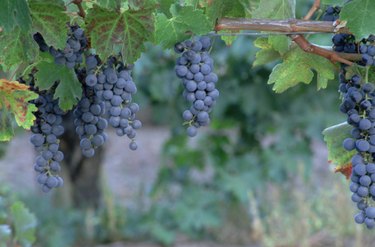
Growing grapes is as much a labor of the brain as the hands, with a little guesswork thrown in for fun. Nearly every aspect of planting and maintaining a grapevine or two takes a little effort and a lot of planning, but the tasty, useful fruit is worth it. Dozens of grape varieties are available to the home gardener, from table grapes you can eat right off the vine to wine grapes that must be plucked at exactly the right moment to get the perfect blend of sugar and acid needed for processing. Both cultivation and cultivar affect when a grapevine will reach optimum fruit production, but the most important part of the equation is patience.
Variety Selection
Video of the Day
Most grape varieties are both male and female and do not need to be planted with another grape variety to set fruit. Some gardeners choose to plant grape varieties that have different ripening dates to lengthen the harvest season. Most muscadine varieties must be planted with other varieties nearby to ensure proper fruiting. Generally, a grapevine produces harvestable fruit when the plant is 2 to 3 years old. Grapevines may produce nothing but foliage for the first two years or they may set a little fruit the first year, a little more the second, and begin bearing in earnest the third year.
Video of the Day
Culture
Grapes require warmth, sunlight, air, fertilizer and water to grow properly. However, too much water or fertilizer can damage the plant or cause the grapevine to produce plenty of lush foliage and no fruit at all. Plant grapevines in well-drained soil so the plant faces southward for maximum sun exposure. In colder climates, try hardy varieties such as Frontenac, Valiant or Swenson's Red. Begin training the vine to a trellis the first year. Trellising controls the vine's spreading habit and keeps the foliage off the ground and properly aerated. Keep the vines moist but not wet.
Pruning
Grapes appear on the current year's growth, but on 1-year-old spurs, so proper pruning is essential to encourage growth and fruiting as well as to improve air circulation that keeps the plant vigorous and healthy. Prune out any dead or diseased canes. Remove nonbearing canes, but keep 2 to 4 canes that have fruiting buds, as these will produce grapes the following season. Prune when necessary to allow more sunlight to penetrate the interior of the grapevine, which helps increase the grape yield and allows the plant to begin producing its first grape crop on time.
Maintenance
Implement a program of fertilization, watering, pruning and training. Perform a soil test every two years to be sure the grapevine is receiving enough nutrients to produce grapes. Grapevines need phosphate, potash and nitrogen, but their specific needs vary depending upon the age of the plant and the results of the soil test. Generally, apply 1/4 lb. of 10-10-10 fertilizer three weeks after planting, spreading the product around but not on the grapevine. Double the amount of fertilizer the second year and each year thereafter until the amount reaches 1 lb. During dry spells, water to a depth of about 1 foot. Maintain a watchful eye for insect activity and symptoms of disease to keep the plants healthy. Bluebell and Kay Gray are cold-hardy varieties with high resistance to diseases.
- University of New Hampshire; Growing Grapes; William Lord; March 2001
- Missouri State University; Growing Grapes in Missouri; John D. Avery, et al.; June 2003
- Oklahoma State University; Growing Grapes in the Home Garden; Julia Whitworth;
- University of Minnesota; Growing Grapes for Home Use; Emily Hoover; 2008
- Ohio State University: Midwest Grape Production Guide
- North Dakota State University; Questions on Grapevines; Ron Smith
- "Mother Earth News"; Growing Grapes and Making Wine; Jef Cox; 2003